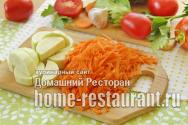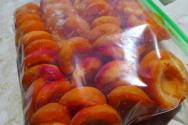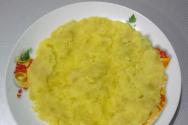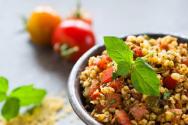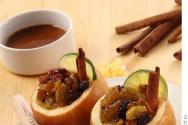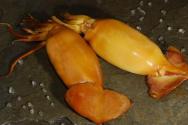German dumplings. German potato dumplings. Gnocchi - Italian dumplings
Spaetzle (German: Spätzle) are simple dumplings made from soft dough. They are popular in German-speaking countries and their surrounding areas: Germany, Austria, Switzerland, Hungary, South Tyrol, etc., and the dish is called differently everywhere. In Hungary, for example, it is “nokedli”, and in Switzerland it is “knöpfle” (Knöpfle or Chnöpfli.) They are spaetzle, something like express noodles: the dough is kneaded very quickly, there is no need to roll out anything, cut or dry it (the semi-liquid dough is “thrown” directly into hot water), and the dumplings are cooked for literally two minutes. There are a minimum of ingredients here, and they are the simplest and most affordable (egg, milk, flour). And the spaetzles turn out to be very tasty, soft, tender, and they can be used in different ways!
You can serve them as a pasta dish on their own - with butter, grated cheese and/or herbs, or, say, fried bacon. You can also use spaetzle as a side dish for rich, satisfying meat or poultry stews with a lot of sauce, for example, paprikash, goulash, beef stroganoff, beef stew. In short, this is an inexpensive, fast, economical and flexible dish.
The only disadvantage of spaetzle is that you need to get used to the process of “throwing” the dough into the water. There are various special devices for this process, or you can make do with improvised means, but in any case, the formation of these dumplings requires some dexterity and agility. In the text of the post I will talk about different methods of preparing them and what works for me personally. But as with any technical skill, mastery comes with practice!
Ingredients:
1 cup flour (cup - 240 ml)
1/2 tsp. salt
a pinch of ground nutmeg (optional)
pinch of ground white pepper (optional)
2 eggs
80 ml milk
30 g butter (for serving, optional)

Mix flour with salt, nutmeg and pepper (if using them.)

Lightly beat the eggs with milk.

Make a well in the flour mixture and pour the egg mixture into it.

Using a wooden spoon or spatula, gradually, moving from the center to the edges, knead the dough.

The dough should be thicker than pancake dough, but softer than typical yeast dough or dumpling dough.

Cover the dough with a towel and let it rest for 15-30 minutes. During this time, its texture will become softer.

Bring water to a boil in a large saucepan and add salt well.
Then the most tricky stage begins - the formation of dumplings. There are special devices for this. I purchased this metal attachment with holes that fits onto the top of the pan (but there are also attachments of other shapes).

If there is no special device, many people use a regular grater:

Or a large spoon/spatula/colander with large holes. The main thing is to quickly push the dough through these holes into the hot water.
[I wouldn't say my attachment is perfect. It doesn’t sit tightly on the pan, it moves back and forth, and while pushing the dough through the holes you have to hold it firmly on the side with an oven mitt. In addition, it heats up very quickly with steam, and the dough begins to weld to it. But, be that as it may, this attachment is much more convenient than the improvised means that I used before (a grater and a large spatula with holes.) Having received this attachment, I made spaetzle for practice three times in two days, and the process became much easier, skill developed.]
So, bring the water to a boil in a saucepan. Reduce the heat to low and keep the water just very hot (this helps to avoid intense steam, which makes it difficult to work with the attachment.) After this, place the attachment (grater, etc.) on the top of the pan...

AND IMMEDIATELY, very quickly put a portion of dough on it. Holding the attachment with your left hand, with your right hand we take a hard plastic or silicone scraper (or spatula) and VERY QUICKLY AND ENERGETICALLY begin to push the dough through the holes of the attachment.

It is important to do this quickly so that the dough does not stick to the attachment at the top and bottom. It also helps to change the angle of the scraper in relation to the nozzle: at an angle of 90 degrees, the remaining dough is easier to “gather in a pile,” and at an angle of 45 degrees, it is easier to push the dough through the holes.
We do the same with the remaining dough. The entire dough yield from this recipe can be pushed into the pan in about three steps, about a minute and a half. In fact, this process is simpler and faster than its description, but, as I already said, a little skill is needed.

This is what pieces of dough that have just fallen into hot water look like. They don’t stick to each other and don’t “go limp” themselves, don’t worry.
From the Bavarian cookbook raised questions, so in the near future I will try to refer more often old recipes and gradually give answers :)
Let's start with dumplings.
To be honest, you can’t get away with one story here, because there is no single correct one. recipe dumplings The question immediately arises as to which ones we are talking about.
You can cook them as a side dish for duck, beef rolls or stewed pork so that they absorb all the precious juices.
Or you can serve them as an independent dish, as a dessert, stuffed with berries or fruits and accompanied with sweet sauce.
What to make it from? From potatoes, cottage cheese, day-old bread, semolina, with the addition of yeast...
The region that gave the world this or that recipe plays a big role.
Even the names are different here.
I thought for a long time whether there was a way to convey differences in the Russian language, but somehow I couldn’t find it. In German, however, there are two equally common words: Knödel and Klöße (distribution map).
Is there a clear fundamental difference between them? I think no; we are talking about the same thing, but in different readings, directly depending on where you are - in the south or in the north.
Although, the controversy does not subside :))
Some say that Knödel has more flour, and Klöße has more potatoes. For others, "Klöße" refers to the use of raw potatoes.
It happens that “Knödel” makes you think about other ingredients in the base: cottage cheese, semolina, etc. But again, it all comes down to geography, because such recipes are circulated mostly in the south.
How else does the region influence?
Well, here are specific examples: very often a Bohemian dumpling is a large yeast roll, boiled and sliced before serving. Indeed often, but not always. In old cookbooks you will find a recipe from Bohemia without yeast, but with onions and parsley.
In Tyrol they take yesterday's bread and mix it with eggs, milk, parsley and speck. Exactly the same thing can be found in Bavaria, which is no wonder - the neighbors have a lot in common.
Again, cottage cheese dumplings, which are served as dessert, are extremely popular in Austria.
The filling can be made from apricots (very popular!), plums, strawberries. All that remains is to add vanilla sauce.
Potato ones can be prepared entirely from boiled potatoes, as they do in Silesia (at the same time giving them an unusual shape - slightly flattened, with a depression in the center), or from raw ones, as in the recipe below.
Coburg dumplings originate from Franconia, a historical region in modern-day Bavaria. By and large, this is a real classic: “dough” made from raw and boiled potatoes, dried bread as a filling.
Dumplings from Thuringia are often taken as the standard and are even protected by place of origin. They use a special variety of potatoes (in general, it’s always good to take the one with more starch), the raw mass is mixed with boiled potatoes and seasoned with vinegar. The bread for the filling can be fried in butter.
I'll try to write a recipe and tell you more when I prepare a story about Thuringia :)
COBURG Dumplings
2 kg potatoes
2 yesterday's buns
salt
Peel the potatoes.
Cut half of it and put it in a saucepan. Add water to cover the potatoes and add salt. Put on fire and boil until done.
Crush the finished potatoes with a potato masher along with the remaining water.
Grate the remaining half of the raw potatoes on a fine grater, place in a towel and squeeze well. Collect the draining liquid and let it stand (starch will collect at the bottom of the dish, it needs to be saved; the liquid itself will no longer be needed).
Mix squeezed raw potatoes with crushed boiled potatoes. Add the salt and starch mentioned above (you can add more if necessary).
Cut the buns into cubes. If the bread is not dry enough, you can dry it in the oven or in a frying pan.
With wet hands, form the potato dough into balls and place some dry bread in the center of each. Roll into a ball again.
Boil water in a large saucepan and add salt. Reduce heat and place dumplings in water. Cook for 15 minutes to half an hour depending on their size.
Serve the finished dumplings with the stew.
Now many people mash potatoes with a blender, and instead of a grater they use an electric meat grinder or something like that. I do it the old fashioned way. They say it's better for the starch contained in potatoes.
There's no flour here. Just wet hands and extra potato starch if the variety is not very suitable.
My dumplings are quite small in size. If you do it exactly according to the rules, then from 2 kg of potatoes you should get 6 pieces.
- Wash the potato tubers thoroughly, peel them, remove the “eyes,” cut them in half and place them in a pan of unsalted water. Cook until softened.
- Drain all the water without any residue. Place the potatoes in a blender bowl and puree them.
- Place the potato mixture in a bowl, add salt, add flour, and break 2 eggs into it. Knead the potato dough. He doesn't need to defend himself.
- Bring chicken broth to a boil. Pinch off small pieces of dough, form them into small balls, roll in flour and throw into boiling broth for 10 minutes.
- Important point: German dumplings are not covered with a lid while cooking in the pan.
- All that remains is to catch the finished potato balls from the broth, use a ladle or slotted spoon to transfer them to a dish, sprinkle with dill and serve.
- This is a fairly simple dish without unnecessary frills and spices, so you can experiment and quickly fry the finished dumplings in olive oil with pieces of fresh tomatoes and spices. Or serve dumplings with meat sauces or goulash.
- Total cooking time: 40 min.
- Category:
Potato dumplings originate from Germany. To be more precise, from Thuringia. Unfortunately, I have not been to Germany, but I know from reliable sources how potato dumplings are prepared there. They know how to cook from potatoes not only in Germany, we Slavs won’t lose face either, but this dish is really quite tasty, as I myself have been convinced of more than once. As a filling, you can use not only croutons as is customary in the traditional recipe.
Why not put fried pieces of meat or minced meat. You can try the vegetable filling, but next time I want to try it with the mushroom filling. I’ll be sure to tell you later what happens. In general, only you decide what and how to prepare the dumplings.
If you haven't finished eating your potato dumplings, put them in the refrigerator, and in the morning fry them on both sides until crispy and have a delicious breakfast on your table. The result will be a dish similar to potato pancakes. Is it true? Here's an example of a very tasty Belarusian one, and pancakes stuffed with elk meat are simply delicious.
I learned about this recipe for potato dumplings from my school friend, who has lived in Germany for more than twenty years and sometimes comes to visit us. I’ll definitely hit him back, especially since he invited me a long time ago. So he gave me a master class on making dumplings.
Thuringian potato dumplings
So, to prepare potato dumplings we need:
Ingredients:
- potato,
- loaf, preferably purchased the day before
- a couple of tablespoons of butter.
I specifically did not indicate how many products you will need since it only depends on how many servings you will prepare.
Dumpling recipe
- First, peel all the potatoes and place them in cold water for a short time.
- Fill a third of the total volume of potatoes with water and put on the fire, they should boil well. It is better to take potatoes that boil well.
- The rest.
- Then wrap it in small portions in a towel and squeeze out the liquid. It is better to do this by pressing it to the edge of the bowl.
- Place all the squeezed potatoes separately in another bowl. After the starch has settled, carefully drain the water and add the starch to the grated potatoes.
- We rub the hot potatoes through a sieve; you can use a special potato press. Rub raw grated potatoes with starch, add salt and mix well. The potato dough should be elastic, stick together well and should not stick to the bowl.
Not a big tip, if the dough is very soft, add flour or instant mashed potatoes to it. Make a test dumpling and boil it to check the quality of the dough. Only then cook the rest of the potato dumplings.
- Next, cut the loaf into small cubes and fry them in butter until they turn golden. We wet our hands with water and make potato dumplings from the dough, placing several crackers in the middle of each one.
- Place the dumplings in boiling salted water, reduce the heat so that the water does not boil, cover with a lid and cook for 25-30 minutes.
If the dumplings rise to the surface, they are ready. It's time to remove them from the pan. Place the finished potato dumplings in a warm dish and serve. You can serve dumplings along with meat dishes. For example, with, or you can just wrap it with butter and sour cream.
Potato dumplings are a dish of simple and hearty peasant cuisine. They are prepared in many countries of the world - in the Czech Republic, Germany, Poland, the Baltic states, and Ukraine. In Italy, potato dumplings are called gnocchi.
Potato dumplings: video recipe
Photo by Shutterstock
Gnocchi - Italian dumplings
For light and fluffy Italian potato gnocchi you will need: - 1 kilogram of large starchy potatoes; - 350 grams of wheat flour; - ½ teaspoon of finely ground salt; - 2 chicken eggs; - a pinch of nutmeg; - rock salt.
Many housewives boil potatoes for dumplings, but in order for the gnocchi to be light and fluffy, the finished potatoes must be dry. You can dry it in a pan, in the oven or bake it in its jacket
Preheat the oven to 150 degrees. Wash the potatoes thoroughly and dry well, prick the entire surface of each tuber with a fork and place the potatoes on a baking sheet thickly covered with rock salt. The salt will absorb the moisture released from the tubers, and you will have a vegetable perfect for dumplings. Bake the potatoes for about an hour; the exact cooking time will depend on the size of the tubers. Remove the finished potatoes from the oven, cool and peel.
Sift 250g of wheat flour onto a work surface along with ½ teaspoon of fine salt and the nutmeg. Puree the peeled, cooled potatoes with a masher and then rub through a sieve. Place in flour, make a well and pour lightly beaten eggs into it. Knead the dough.
Sprinkle your work surface with flour and roll out the potato dough into a square 1.5 centimeters thick. Cut the layer into strips of the same thickness, roll each into a small sausage and cut into pieces no wider than 1 centimeter. Dust the dumplings with flour and use the tines of a fork to make a small indentation in each.
Bring lightly salted water to a boil in a large, wide saucepan, add the gnocchi in batches and cook for about 10 minutes until the gnocchi float to the surface. Serve with tomato, cream or other thin, spicy sauce.
German potato dumplings recipe
German dumplings are much larger and heartier than their Italian counterparts. You will need: - 1 kilogram of starchy potatoes; - 1 and ½ teaspoons of salt; - ½ cup of wheat flour; - 1/8 cup of corn starch; - 1 chicken egg; - 2 slices of white bread mixed with sourdough; - 1 tablespoon a spoonful of butter; - 1 tablespoon of vegetable oil.

